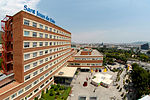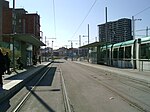Barcelona Ladies Open
The Barcelona Ladies Open was a tennis tournament for women held in Barcelona in Catalonia (Spain) and was played on outdoor clay courts. It was an International-level tournament on the WTA Tour with total prize money of $220,000. The tournament began in November 2003 as a $10,000 challenger event on the ITF Women's Circuit. Prize money was increased to $25,000 the following year; in 2005, the event was moved to October with the prize money increasing to $75,000. In 2007, the tournament was upgraded to the Sony Ericsson WTA Tour, becoming a Tier IV played in June, and remained in this classification through 2008. Since 2009, the event has been held in April. In 2013 the event was cancelled due to financial reasons and replaced on the tour by the Nuremberg Cup in Nuremberg, Germany, held the week before Roland Garros.
Excerpt from the Wikipedia article Barcelona Ladies Open (License: CC BY-SA 3.0, Authors).Barcelona Ladies Open
Avinguda d'Albert Bastardas, Barcelona
Geographical coordinates (GPS) Address Nearby Places Show on map
Geographical coordinates (GPS)
| Latitude | Longitude |
|---|---|
| N 41.382777777778 ° | E 2.1086111111111 ° |
Address
David Lloyd Club Turó
Avinguda d'Albert Bastardas
08001 Barcelona
Catalonia, Spain
Open on Google Maps





